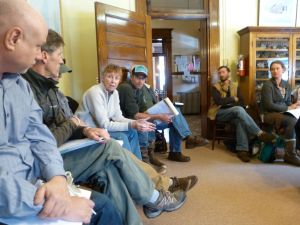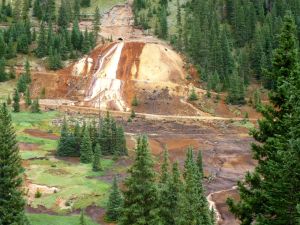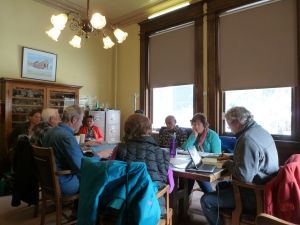By Samantha Wright

The Red and Bonita mine near Silverton is a target of the Animas River Stakeholders Group’s work to repair water quality in the Animas River watershed.
For 21 years, an unlikely alliance of mining companies, environmental organizations, landowners, local governmental entities, and state and federal regulatory and land management agencies has converged faithfully on the third Thursday of almost every month in the tiny, isolated town of Silverton in the San Juan Mountains of southwestern Colorado.
Collectively known as the Animas River Stakeholders Group, the coalition’s mission is to clean up the unfinished business of previous centuries—the environmental damage wrought by abandoned mines—by improving water quality and habitats in the Animas River through a collaborative process.
As such, the group is a poster child for a key goal of the draft of Colorado’s Water Plan, which in Chapter 7 supports the development of watershed coalitions and watershed master plans, while emphasizing the ways in which stakeholders can work together to promote watershed health.
It is a critical mission. According to Trout Unlimited, more than 500,000 abandoned hard-rock mines remain across the western United States with an estimated cleanup cost ranging from $36-72 billion. In Colorado, heavy metals draining from an estimated 23,000 abandoned mines are a primary culprit in the state’s approximately 9,548 impaired river miles.
A toxic legacy
Hundreds of these abandoned and inactive mine sites dot the mountainsides of the upper Animas watershed surrounding Silverton, where metal mining was an economic mainstay from the 1870s through the early 1990s. In addition to their picturesque ruins and colorful histories, the mines bear the unfortunate legacy of metal-loading to alpine streams and creeks, adding to natural metal-loading that already occurs in this highly mineralized area.
The Animas River Stakeholders Group coalesced in 1994, just after the last mine in the area had closed, to fend off the specter of a Superfund designation in the upper Animas River Basin, and to come up with a process for determining attainable water quality standards in the basin.

The Animas River Stakeholders Group has operated for 21 years to convene concerned landowners, mine operators, experts from federal and state agencies, and members of environmental groups and local government in a collaborative, grassroots process.
In its first years of operation, the group sampled some 200 abandoned mine sites, then prioritized 33 in need of the most work. The group directly sponsored close to 20 mine remediation projects in the upper Animas River watershed and was indirectly involved in 40 more, considerably improving the water quality in several tributaries to the Animas River, including Mineral and Cement creeks. They also developed recommendations for a number of site-specific water quality standards that were ultimately adopted by the Colorado Water Quality Control Commission.
Because of the liability stemming from the Clean Water Act that is associated with directly treating polluted mine drainage, most of the Animas Stakeholders’ remediation projects have focused on prevention through isolation of reactive mineralized material from water, either by removing tailings and waste rock from a drainage (and in a few cases reprocessing it at a local mill), capping it with an impermeable material, or diverting water that previously fed into old mine workings and tailings piles to minimize metal-loading.

An unplugged tunnel at the Red and Bonita mine in the upper Cement Creek drainage began leaking after the water table rose due to nearby installed plugs.
A turning point in the Animas River Stakeholder Group’s mission came after the last mining company to operate in Silverton, Sunnyside Gold Corp., built three massive bulkheads inside the vast underground workings of the Sunnyside Mine in the upper Cement Creek drainage starting in 1996 as part of an agreement with the State of Colorado that released the mine company from environmental liability.
The bulkheads were intended to act as corks, simply preventing water from draining out of the mine. The first one worked well, but when two more were added downstream in the tunnel six years later, the bulkheads collectively ended up functioning more as a bathtub plug, causing the water table inside the mountain to rise and eventually gush out of other mine adits—horizontal passages leading into a mine for the purposes of access or drainage—higher in the upper Cement Creek drainage.
Today, the volume of polluted water pouring out of a group of these adits, all on the same slope—the American Tunnel, the Red and Bonita, the Gold King, and the Mogul—is equal to the contributions of the 33 most-polluting mines the Animas Stakeholders group identified during its initial study 15 years ago.
Collectively, these leaky adits have created one of the largest untreated mine drainages in Colorado, a festering sore oozing a toxic cocktail of heavy metals including zinc, cadmium, copper, manganese, iron, aluminum and lead. Making matters worse, once it is exposed to the open air, the water draining from the mines becomes highly acidic due to the weathering of iron pyrites.

An open tunnel, or adit, of the abandoned Gold King Mine continues to leak acidic heavy metals into upper Cement Creek.
In short, all of the hard-won gains in water quality that the Animas River Stakeholders Group made in its first decade were washed away as the water quality of the Animas River below Cement Creek worsened between 2005 and 2010. Metal-loading in the stream killed off three out of four fish species as well as a host of bugs and insects that formerly lived there, and sent toxic levels of zinc as far downstream as Baker’s Bridge near Durango.
Seeking a solution
Today, the Animas Stakeholders group is primarily focused on finding a solution to this problem that is amenable to everyone at the table.
The most comprehensive—and expensive—fix would be to install a permanent limestone water treatment plant in the upper Cement Creek drainage, which would cost upwards of $17 million to build and at least a million dollars a year to operate in perpetuity. This solution would likely only be feasible if a Superfund site were declared, potentially putting Sunnyside and its parent Kinross Gold Corp., an international mining conglomerate that has generated billions in annual revenue in recent years, on the hook to help foot the bill.
Sunnyside has threatened legal action if the U.S. Environmental Protection Agency pursues a Superfund designation, and the community of Silverton is also largely opposed to the idea, fearing it would scare away tourists as well as prospective new mine operations, thus damaging an economy that is as already as fragile as alpine tundra.
Rather than squabbling over the politics of Superfund, the Animas Stakeholders (whose members include designees from both EPA and Sunnyside) are working to determine if it is possible to reduce the volume of water coming out of the leaky mines in the upper Cement Creek drainage by putting in new bulkheads, thereby perhaps eliminating the need for a permanent water treatment plant—and Superfund designation.
The EPA plans to install the first of these new bulkheads in the Red and Bonita Mine this summer.
“If you could get even a 50 percent reduction in the amount of metals coming out of there, that would be a big win,” said Peter Butler, one of three co-coordinators for the Animas River Stakeholders Group and former chair of the Colorado Water Quality Control Commission. “That would still be a lot cheaper than treating it.”
The group is also interested in finding alternative water treatment techniques that would cost less to operate than a full-scale water treatment plant.
Finding money…and success
In recent years, money for abandoned mine reclamation projects has become increasingly scarce due to state and federal cutbacks to two of the Animas Stakeholder’s primary funding sources.
Congress has steadily hacked away at the EPA’s Section 319 Grant Program, which was established by amendment to the federal Clean Water Act in 1987 to provide funding for efforts to reduce nonpoint source pollution. Making matters worse, the application process for 319 grants has become “much more cumbersome as the EPA keeps adding more and more requirements,” Butler said.
Meanwhile, the State of Colorado has lately taken to raiding its mineral severance tax revenues to balance the state budget, leaving less of those funds to pay for reclamation projects through the state’s Division of Reclamation, Mining and Safety.
“It’s getting harder and harder to find funding,” Butler said. “Fortunately, there are not many mine waste piles left that we want to address.”
The Animas Stakeholders’ ongoing operations expenses are paid for through a variety of sources including 319 grants, the U.S. Bureau of Land Management, the Southwestern Water Conservation District, and Sunnyside Gold Corp.
Meanwhile, funding for the bigger problem of treating polluted mine drainage “is mostly nonexistent at this point,” Butler said, because of liability issues stemming from the Clean Water Act. “Those projects will be expensive and will have ongoing expenses over time.”

Meetings of the Animas River Stakeholders Group, pictured in early 2015, are held monthly in Silverton and are open to the public.
The structure of the Animas River Stakeholders Group is unique among the 85 groups listed in the Colorado Watershed Assembly’s 2014 Watershed Group Directory. It is not an incorporated entity, and it operates by informal consensus, thus sidestepping the hassle of determining which interest would have how many seats on the board of directors and how much say-so they would have.
“We just wanted to avoid that,” Butler said. “Particularly because initially there was a lot more contention between different people participating in the group.”
The sheer volume of water sampling and remediation projects that the group has executed over the past two decades has made it a role model for neighboring watershed groups, such as the recently incorporated Uncompahgre Watershed Partnership, which has embarked on its own journey to improve the water quality of impaired segments of the Uncompahgre River through passive remediation at abandoned mines on the other side of Red Mountain Pass.
What’s the secret to the Animas Stakeholders’ success? “We have a lot of very sharp, capable people,” Butler said. “Everyone is highly motivated, because the alternative is potentially having an outside government agency step in and take over.”
 Samantha Wright is an independent journalist based in southwestern Colorado. She is a founding member of the San Juan Independent (http://sjindependent.org/), a nonprofit online news source offering in-depth reporting on issues of importance in the western San Juan Mountains. Visit her online at http://samanthatisdelwright.pressfolios.com/.
Samantha Wright is an independent journalist based in southwestern Colorado. She is a founding member of the San Juan Independent (http://sjindependent.org/), a nonprofit online news source offering in-depth reporting on issues of importance in the western San Juan Mountains. Visit her online at http://samanthatisdelwright.pressfolios.com/.
 For more information, read the Colorado Foundation for Water Education’s Citizen’s Guide to Colorado Water Quality Protection. And consider attending The Mining Institute’s San Juan Mining and Reclamation Conference, which will be held May 28 and 29 in Telluride.
For more information, read the Colorado Foundation for Water Education’s Citizen’s Guide to Colorado Water Quality Protection. And consider attending The Mining Institute’s San Juan Mining and Reclamation Conference, which will be held May 28 and 29 in Telluride.

 Print
Print
Then there are the heavy metals coming from many undersea hydrothermal vents:
http://www.nature.com/ngeo/journal/v4/n3/full/ngeo1088.html
Reblogged this on raekellypointofview.
I would like to hear the details of the ARSG proposals to do new bulkheads to block the mining tunnels. How would they change the construction? How would these create a different outcome from the back pressures that are occurring now with the previous bulkheads in place?